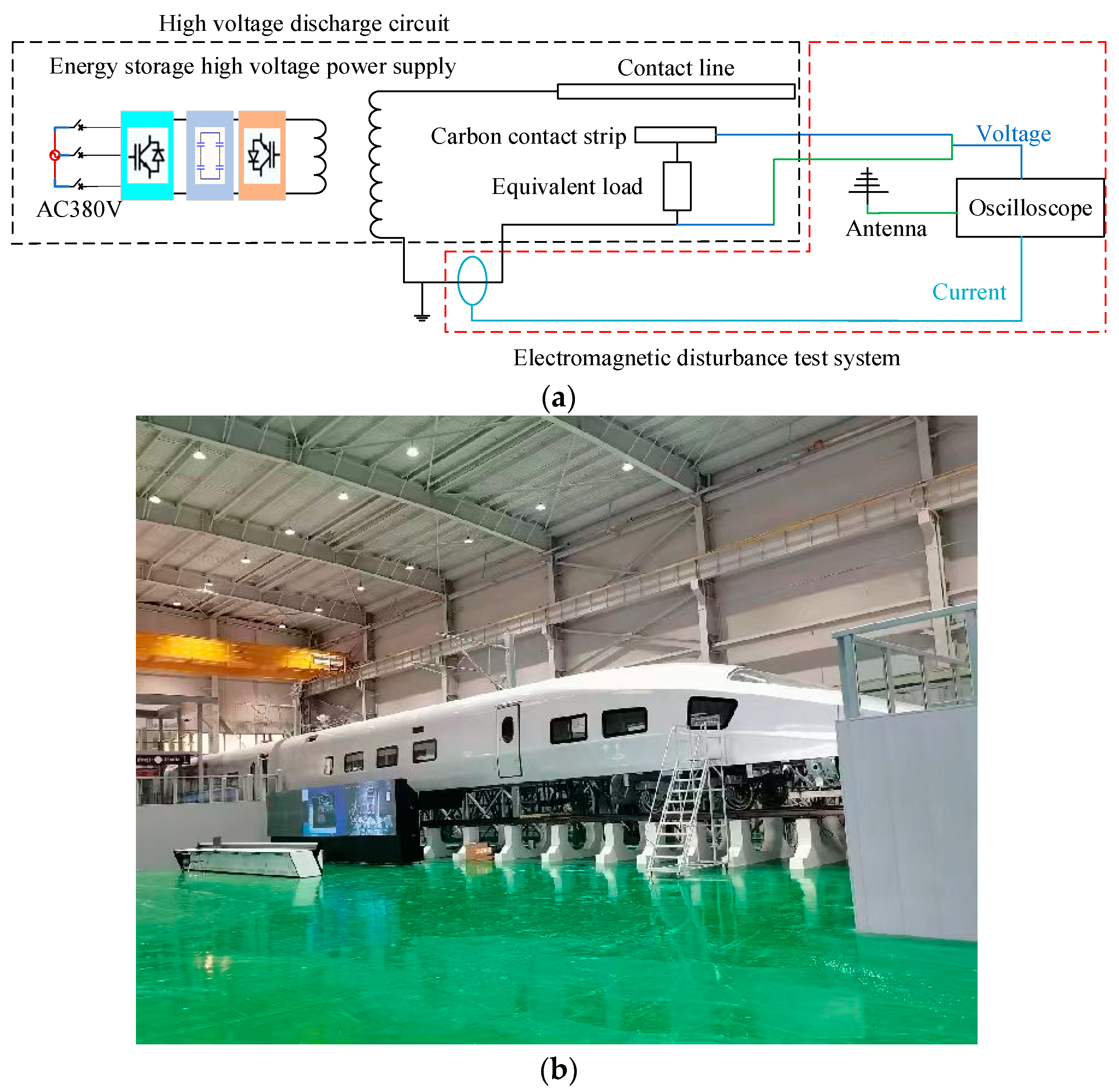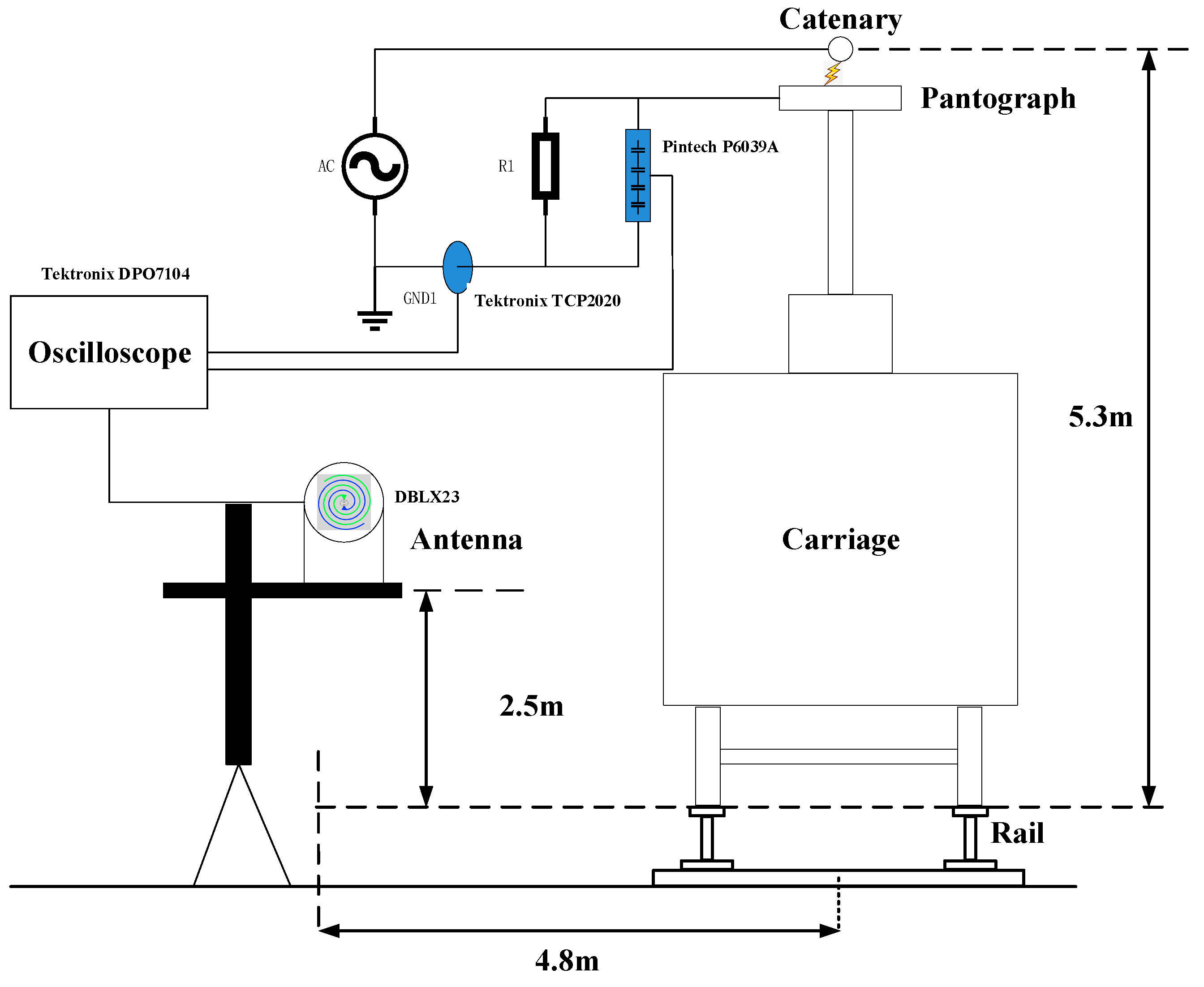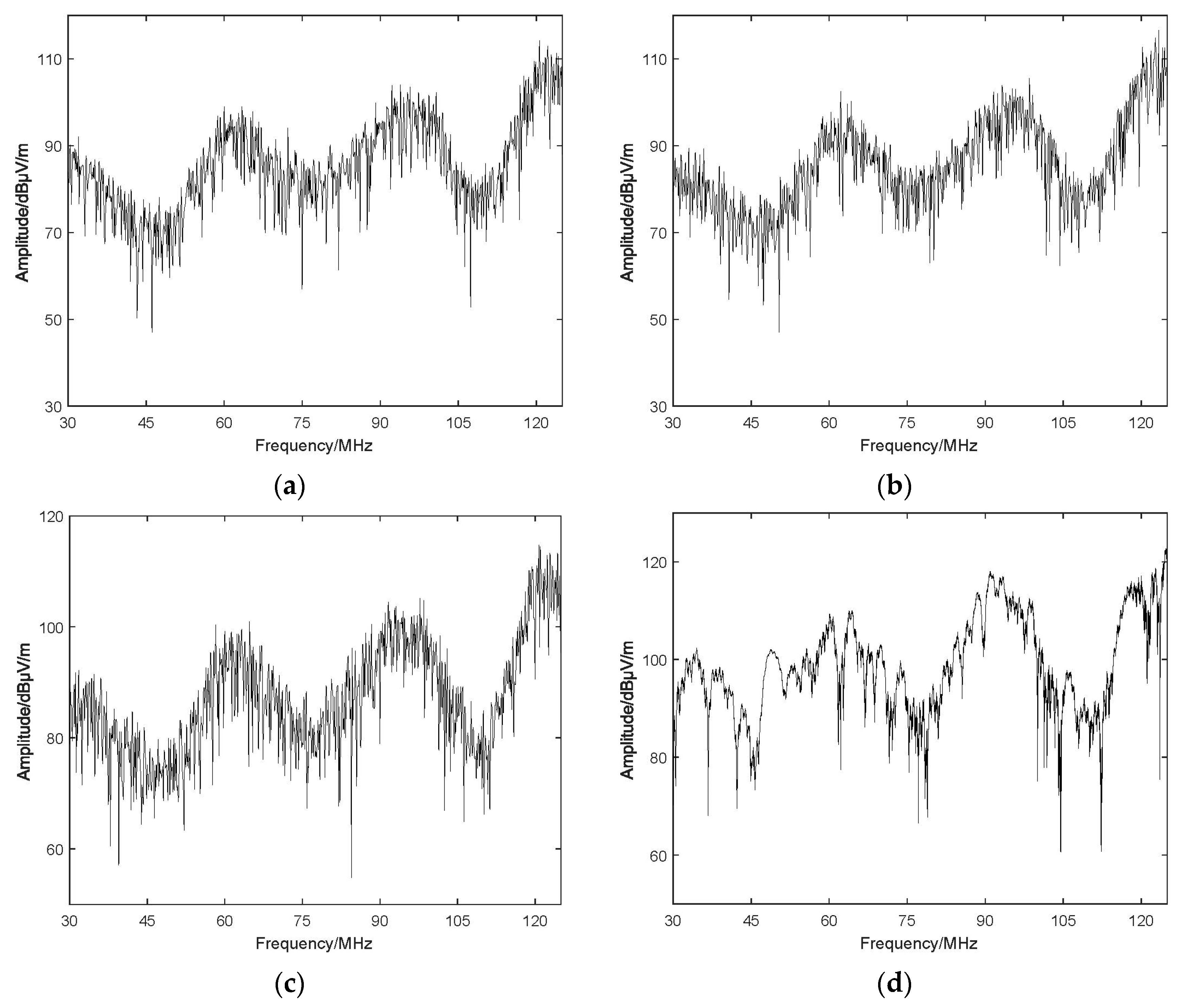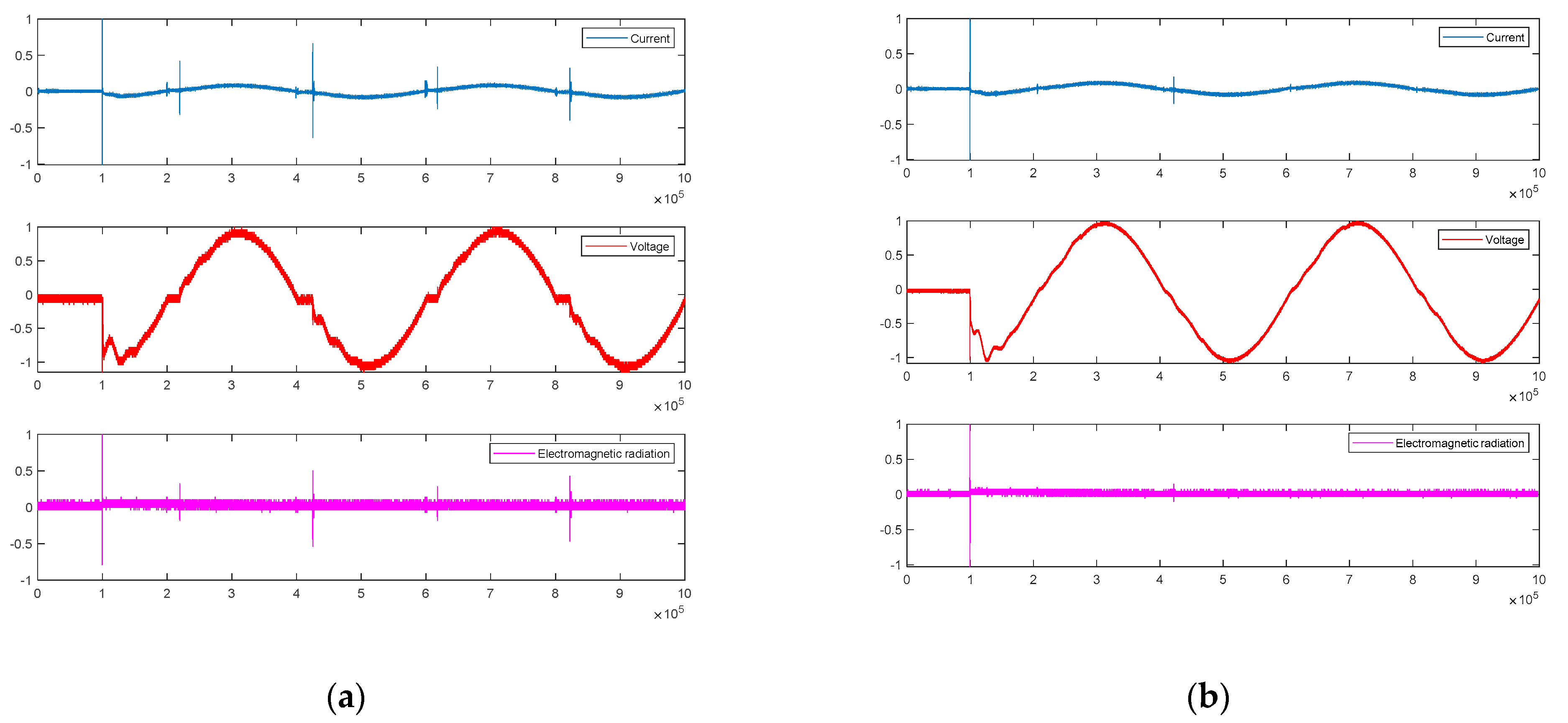Research on the Influence of Pantograph Catenary Contact Loss Arcs and Zero-Crossing Stage on Electromagnetic Disturbance in High-Speed Railway
Abstract
:1. Introduction
2. AC Arc Zero-Crossing Stage and Physical Processes in The Pantograph–Catenary Contact Loss
- (1)
- In the case of a small-contact-loss scenario, if an arc is generated and the current does not pass through the zero point, the distance between the pantographs decreases until they make contact again, causing the arc to naturally extinguish. However, if the arc is generated and the current passes through the zero point, the arc also naturally extinguishes. In this situation, as the distance between the pantographs decreases, the gap is pierced again, and the arc is rekindled until the pantographs make contact once more, leading to the extinction of the arc.
- (2)
- For medium- and large-contact-loss scenarios, when an arc is generated, the current inevitably passes through the zero point, and the arc naturally extinguishes. Since there is no arc extinguishing medium in the air, in cases where the mechanical gap between the pantographs during contact loss is relatively small, the arc can reignite after passing through the zero point, ultimately achieving a stable arc-burning state. If the mechanical gap is sufficiently large, the arc may completely extinguish. However, as the gap between the pantographs decreases, the pantographs may break the arc again, leading to the reignition of the arc. This cycle continues until the pantographs make contact once more, causing the arc to disappear.
3. Test of The Electromagnetic Disturbance Characteristics of Pantograph–Catenary Discharge
3.1. Experimental Platform Construction
3.2. Test Methodology
4. Test Results and Analysis
5. Conclusions
- (1)
- We have, for the first time, identified the distortion in voltage waveforms during the gap breakdown discharge of the pantograph–catenary under high-voltage, high-current conditions. The current waveform comprises a 50 Hz steady-state current and transient pulse clusters, and the electric field spectrum exhibits radiation across the 30 MHz to 125 MHz range, with an overall variation of 60 dBuV/m to 123 dBuV/m.
- (2)
- With an increase in the power supply voltage, the voltage at both ends of the load also increases, and the extent of distortion in the voltage waveform gradually diminishes. Additionally, the amplitudes of the 50 Hz steady-state current and transient pulse clusters within the discharge circuit are significantly amplified. The radiation intensity generated by the pantograph–catenary discharge increases, particularly in the vicinity of the 125 MHz frequency point. When the output voltage ascends from 20% Umax to 80% Umax, the radiation intensity near this frequency point increases by approximately 10 dB.
- (3)
- The electromagnetic radiation amplitude is greatest at the instant of the pantograph–catenary gap breakdown. During the stable arc ignition stage of the pantograph–catenary gap, the arc current crosses zero twice per cycle, resulting in the occurrence of zero-current phenomena. Our initial tests confirm that under high-voltage, high-current conditions during the pantograph–catenary discharge arc’s zero-crossing period, pulse currents are generated, accompanied by the emission of substantial electromagnetic interference signals. With the increase in arc current, the zero-crossing time decreases, the number of charged particles in the pantograph catenary gap increases, and the pulse current during the zero-crossing process diminishes, accompanied by reduced electromagnetic radiation. This reveals new characteristics of electromagnetic radiation interference during steady-state arc ignition.
Author Contributions
Funding
Data Availability Statement
Conflicts of Interest
References
- Midya, S.; Thottappillil, R. An overview of electromagnetic compatibility challenges in European Rail Traffic Management System. Transp. Res. Part C Emerg. Technol. 2008, 16, 515–534. [Google Scholar] [CrossRef]
- Mariscotti, A. Critical review of EMC standards for the measurement of radiated electromagnetic emissions from transit line and rolling stock. Energies 2021, 14, 759. [Google Scholar] [CrossRef]
- Seferi, Y.; Blair, S.M.; Mester, C.; Stewart, B.G. A novel arc detection method for dc railway systems. Energies 2021, 14, 444. [Google Scholar] [CrossRef]
- Zhang, Y.; Li, C.; Pang, X.; Song, C.; Ni, F.; Zhang, Y. Evolution processes of the tribological properties in pantograph/catenary system affected by dynamic contact force during current-carrying sliding. Wear 2021, 477, 203809. [Google Scholar] [CrossRef]
- Yang, H.; Li, C.; Liu, Y.; Fu, L.; Jiang, G.; Cui, X.; Hu, B.; Wang, K. Study on the delamination wear and its influence on the conductivity of the carbon contact strip in pantograph-catenary system under high-speed current-carrying condition. Wear 2021, 477, 203823. [Google Scholar] [CrossRef]
- Zhou, H.; Duan, F.; Liu, Z.; Chen, L.; Song, Y.; Zhang, Y. Study on electric spark discharge between pantograph and catenary in electrified railway. IET Electr. Syst. Transp. 2022, 12, 128–142. [Google Scholar] [CrossRef]
- Li, M.; Wen, Y.; Sun, X.; Wang, G. Analysis of propagation characteristics of electromagnetic disturbance from the off-line of panto-graph-catenary in high-speed railway viaducts. Chin. J. Electron. 2020, 29, 966–972. [Google Scholar] [CrossRef]
- Cai, S.; Li, Y.; Zhu, H.; Wu, X.; Su, D. A novel electromagnetic compatibility evaluation method for receivers working under pulsed signal interference environment. Appl. Sci. 2021, 11, 9454. [Google Scholar] [CrossRef]
- Pous, M.; Silva, F. Full-spectrum APD measurement of transient interferences in time domain. IEEE Trans. Electromagn. Compat. 2014, 56, 1352–1360. [Google Scholar] [CrossRef]
- Dudoyer, S.; Deniau, V.; Adriano, R.; Slimen, M.N.B.; Rioult, J.J.; Meyniel, B.; Berbineau, M. Study of the susceptibility of the GSM-R communications face to the electromagnetic interferences of the rail environment. IEEE Trans. Electromagn. Compat. 2011, 54, 667–676. [Google Scholar] [CrossRef]
- Zhu, F.; Tang, Y.; Gao, C. Mechanism and suppression of electromagnetic interference of pantograph-catenary arc to speed sensor of CRH380BL electric multiple unit. China Railw. Sci. 2016, 37, 69–74. [Google Scholar]
- Midya, S.; Bormann, D.; Larsson, A.; Schutte, T.; Thottappillil, R. Understanding pantograph arcing in electrified railways—Influence of various parameters. In Proceedings of the 2008 IEEE International Symposium on Electromagnetic Compatibility, Detroit, MI, USA, 18–22 August 2008; pp. 1–6. [Google Scholar]
- Jin, M.; Hu, M.; Li, H.; Yang, Y.; Liu, W.; Fang, Q.; Liu, S. Experimental study on the transient disturbance characteristics and influence factors of pantograph-catenary discharge. Energies 2022, 15, 5959. [Google Scholar] [CrossRef]
- Li, X.; Zhu, F.; Lu, H.; Qiu, R.; Tang, Y. Longitudinal propagation characteristic of pantograph arcing electromagnetic emission with high-speed train passing the articulated neutral section. IEEE Trans. Electromagn. Compat. 2018, 61, 319–326. [Google Scholar] [CrossRef]
- Song, Y.; Rønnquist, A.; Jiang, T.; Nåvik, P. Railway pantograph-catenary interaction performance in an overlap section: Modelling, validation and analysis. J. Sound Vib. 2023, 548, 117506. [Google Scholar] [CrossRef]
- Yao, Y.; Zou, D.; Zhou, N.; Mei, G.; Wang, J.; Zhang, W. Study on the mechanism of vehicle body vibration affecting the dynamic interaction in the pan-tograph-catenary system. Veh. Syst. Dyn. 2021, 59, 1335–1354. [Google Scholar] [CrossRef]
- Song, Y.; Wang, Z.; Liu, Z.; Wang, H. A spatial coupling model to study dynamic performance of pantograph-catenary with vehicle-track excitation. Mech. Syst. Signal Process. 2020, 151, 107336. [Google Scholar] [CrossRef]
- Van, O.V.; Massat, J.-P.; Laurent, C.; Balmes, E. Introduction of variability into pantograph–catenary dynamic simulations. Veh. Syst. Dyn. 2014, 52, 1254–1269. [Google Scholar] [CrossRef]
- Wang, H.; Gao, G.; Deng, L.; Li, X.; Wang, X.; Wang, Q.; Wu, G. Study on Current-Carrying Tribological Characteristics of C-Cu sliding electric contacts under different water content. Coatings 2023, 13, 42. [Google Scholar] [CrossRef]
- Tellini, B.; Macucci, M.; Giannetti, R.; Antonacci, G.A. Line-pantograph EMI in railway systems. IEEE Instrum. Meas. Mag. 2001, 4, 10–13. [Google Scholar] [CrossRef]
- Tellini, B.; Macucci, M.; Giannetti, R.; Antonacci, G. Conducted and radiated interference measurements in the line-pantograph system. IEEE Trans. Instrum. Meas. 2001, 50, 1661–1664. [Google Scholar] [CrossRef]
- Midya, S. Conducted and Radiated Electromagnetic Interference in Modern Electrified Railways with Emphasis on Pantograph Arcing; KTH: Stockholm, Sweden, 2009. [Google Scholar]
- Wang, W. Study of Dynamic Characteristic for High Speed Railway Pantograph Arcing; Southwest Jiaotong University: Chengdu, China, 2013. [Google Scholar]
- Wu, G.; Wu, J.; Wei, W.; Zhou, Y.; Yang, Z.; Gao, G. Characterization of sliding electrical contact of pantograph-catenary system. High Volt. Engi-Neering 2015, 41, 3635–3641. [Google Scholar]
- Gu, Z. Experimental Study on Morphological Characteristics and Plasma Parameters of Pantograph-Catenary Arc; Southwest Jiaotong University: Chengdu, China, 2016. [Google Scholar]
- Gao, G.; Yan, X.; Yang, Z.; Wei, W.; Hu, Y.; Wu, G. Pantograph-catenary arcing detection based on electromagnetic radiation. IEEE Trans. Electromagn. Compat. 2018, 61, 983–989. [Google Scholar] [CrossRef]
- Gao, G.; Yan, X.; Wei, W.; Hu, Y. Electromagnetic radiation of pantograph-catenary arc based on Hilbert fractal antenna. High Volt. Eng. 2019, 45, 324–329. [Google Scholar]
- Guo, F.; Wang, X.; Wang, Z.; Wang, D.; Wang, B. Experimental research on total harmonic distortion of contact current caused by panto-graph-catenary off-line. Trans. China Electrotech. Soc. 2015, 30, 261–266. [Google Scholar]
- Guo, F.; Wang, X.; Wang, Z.; Zhang, Y.; Wang, B. Research on radiated electric field noise of pantograph arc. Trans. China Electro-Tech. Soc. 2015, 30, 220–225. [Google Scholar]
- Gortschakow, S.; Franke, S.; Methling, R.; Gonzalez, D.; Lawall, A.; Taylor, E.D.; Graskowski, F. Properties of vacuum arcs generated by switching RMF contacts at different ignition positions. Energies 2020, 13, 5596. [Google Scholar] [CrossRef]









| No. | Designation | Model Number | Main Parameters |
|---|---|---|---|
| 1 | AC high-voltage generator | Frequency, 50 Hz; maximum output voltage, 50 kV; rated capacity, 5 kVA | |
| 2 | Contact wire | CT85 | Resistivity, 0.0177 Ω∙mm2∙m−1 |
| 3 | Carbon contact strip | JL-14 | Resistivity, 13 Ω∙mm2∙m−1 |
| 4 | Current-limiting resistor | High-voltage non-inductive resistance, 560 kΩ | |
| 5 | Oscilloscope | Tektronix DPO7104 | Bandwidth, 1 GHz Maximum sampling rate, 40 GS/s |
| 6 | Helical antenna | DBLX23 | Frequency response range, 30 MHz–2 GHz |
| 7 | Voltage probes | Pintech P6039A | Bandwidth, 220 MHz; maximum test voltage, AC 1–28 kV (50/60 Hz) |
| 8 | Current probes | Tektronix TCP2020 | Bandwidth, 50 MHz; high current: 20 A RMS Pulse current, 100 A peak; rise time: <7 ns |
| Voltage Level | 20% Umax | 40% Umax | 60% Umax | 80% Umax | |
|---|---|---|---|---|---|
| Peak of Discharge Parameter | |||||
| Load Voltage (kV) | 3.42 | 4.15 | 10.18 | 17.65 | |
| Electric Field for 125 MHz (dBμV/m) | 111.3 | 112.5 | 114.8 | 122.8 | |
Disclaimer/Publisher’s Note: The statements, opinions and data contained in all publications are solely those of the individual author(s) and contributor(s) and not of MDPI and/or the editor(s). MDPI and/or the editor(s) disclaim responsibility for any injury to people or property resulting from any ideas, methods, instructions or products referred to in the content. |
© 2023 by the authors. Licensee MDPI, Basel, Switzerland. This article is an open access article distributed under the terms and conditions of the Creative Commons Attribution (CC BY) license (https://creativecommons.org/licenses/by/4.0/).
Share and Cite
Yang, Y.; Cao, H.; Zhang, M.; Su, Z.; Hu, M.; Jin, M.; Liu, S. Research on the Influence of Pantograph Catenary Contact Loss Arcs and Zero-Crossing Stage on Electromagnetic Disturbance in High-Speed Railway. Energies 2024, 17, 138. https://doi.org/10.3390/en17010138
Yang Y, Cao H, Zhang M, Su Z, Hu M, Jin M, Liu S. Research on the Influence of Pantograph Catenary Contact Loss Arcs and Zero-Crossing Stage on Electromagnetic Disturbance in High-Speed Railway. Energies. 2024; 17(1):138. https://doi.org/10.3390/en17010138
Chicago/Turabian StyleYang, Yixuan, Hefei Cao, Mingzhi Zhang, Zhiguo Su, Man Hu, Mengzhe Jin, and Shanghe Liu. 2024. "Research on the Influence of Pantograph Catenary Contact Loss Arcs and Zero-Crossing Stage on Electromagnetic Disturbance in High-Speed Railway" Energies 17, no. 1: 138. https://doi.org/10.3390/en17010138
APA StyleYang, Y., Cao, H., Zhang, M., Su, Z., Hu, M., Jin, M., & Liu, S. (2024). Research on the Influence of Pantograph Catenary Contact Loss Arcs and Zero-Crossing Stage on Electromagnetic Disturbance in High-Speed Railway. Energies, 17(1), 138. https://doi.org/10.3390/en17010138





